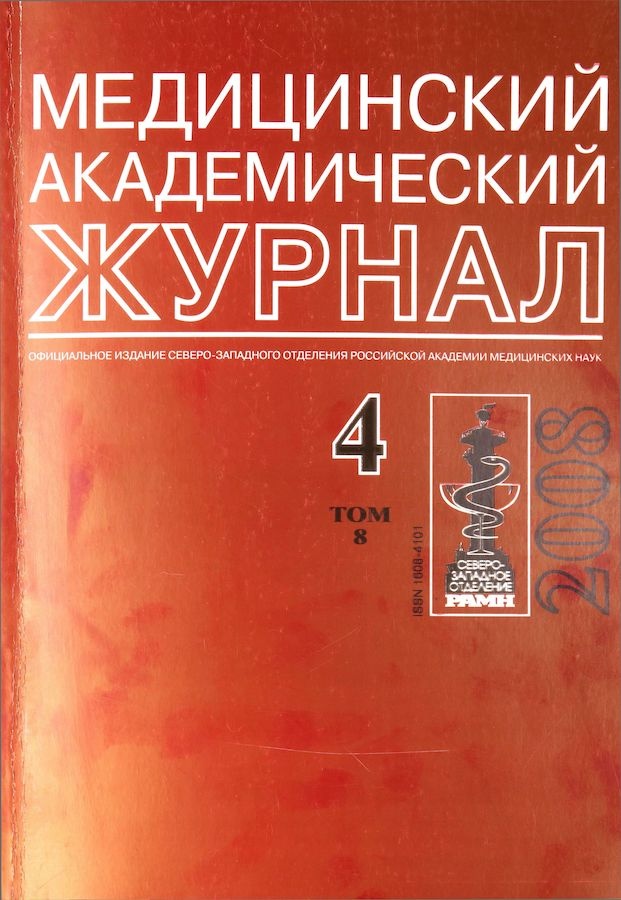lnfluence of different methods of anesthesia on postoperative respiratory function
- Authors: Bogdanets A.I.1, Shishkin O.I.2, Zilber A.P.1
-
Affiliations:
- Petrozavodsk State University
- Republican hospital of Karelia
- Issue: Vol 8, No 4 (2008)
- Pages: 71-77
- Section: Clinical medicine
- Published: 27.11.2008
- URL: https://journals.eco-vector.com/MAJ/article/view/693921
- ID: 693921
Cite item
Abstract
The aim of our study was to analyze mechanisms by which lung ventilation is compromised in settings of general and spinal anesthesia.
Methods: Forced oscillation technique and spirometry provided assessment of respiratory mechanics whereas measurement of both respiratory muscle strength and central output were obtained by occlusion technique (Рех, Pin and Р100 respectively). Examination of respiratory function was performed in patients undergoing general (n=25) ог spinal (n=25) anesthesia for lower abdominal and limb surgery.
Results: lndex of P100 had not significantly changed in general anesthesia group. There was а short trend of decreasing of Р100 in group of spinal anesthesia. There's а significant reduction of respiratory muscles strength after surgery under general anesthesia: preoperatively Pin 75,8±26,1 cm H2O, Рех 112,5±39,4 cm H2O and postoperatively Pin 57,8±31,7 cm Н2O, Рех 61,7±31,3 cm H2O, р<0,01. Only function of expiratory muscles was compromised in spinal anesthesia group. Вy the end of general anesthesia respiratory resistance (R5) increased by 32% in average. No change of respiratory resistance was observed after spinal anesthesia.
Conclusions: General anesthesia combined with surgical factors produces detrimental effect on respiratory system involving inspiratory and expiratory muscles as well as lung mechanics. Combination of spinal anesthesia with similar surgical factors has lesser impact limited by expiratory muscle dysfunction and slight weakening of central drive.
About the authors
A. I. Bogdanets
Petrozavodsk State University
Email: medaj@eco-vector.com
Russian Federation, Petrozavodsk
O. I. Shishkin
Republican hospital of Karelia
Email: medaj@eco-vector.com
Russian Federation, Petrozavodsk
A. P. Zilber
Petrozavodsk State University
Author for correspondence.
Email: medaj@eco-vector.com
Russian Federation, Petrozavodsk
References
- Богданец А. И. Послеоперационные дыхательные расстройства: Новые методы функциональной диагностики и респираторной терапии: Дис. … канд. мед. наук. СПб., 2006. 13lc.
- Зайцев А. Ю., Светлов В. А., Козлов С П. и др. Клинико-патофизиологические предпосылки для нарушения внешнего дыхания и возможные пути достижения безопасности при медикаментозной депрессии сознания // Анестезиол. и реаниматол. 2004. № 5. С. 55-61.
- Зильбер А. П. Этюды критической медицины // Т. 2. Респираторная медицина. Петрозаводск, 1996. 488 с.
- Зильбер А. П. Анестезиологическое обеспечение респираторной медицины //Акт. пр. МКС. 2002. Вып. 9.
- Зильбер Э. К. Функциональная оценка респираторной терапии по трем компонентам дыхательной недостаточности: Дис. … канд. мед. наук. СПб., 2001. 128 с.
- Овечкин А. М., Осипов С. А. Клиническая эффективность эпидуральной и спинальной анестезии с точки зрения доказательной медицины // Регионарная анестезия и лечение боли. Тематический сборник / Под ред. А. М. Овечкина, С. И. Ситкина. Тверь, 2004. 280 с.
- Петрова М. В., Воскресенский С. В., Краснова Т. Е. Изменения механических свойств легких при торакальных операциях у онкологических больных // Анестезиол и реаниматол 2001 № 5 С 16-19
- Раввин М. С. Окклюзионное давление дыхательных путей как объективный критерий центральной регуляции дыхания при интенсивной респираторной терапии и анестезиологическом пособии: Дис. … канд. Мед. наук Петрозаводск, 1992 142 с
- Ротен Х. Улучшение оксигенации во время операции // Актуальные проблемы анестезиологии и реаниматологии Освежающий курс лекций Архангельск, 2005 С 11-18
- Paskin S., Rodman Т., Smith Т. С. The Effect of Spinal Anesthesia on the Pulmonary Function of Patients with Chronic Obstructive Pulmonary Disease // Annals of surgery 1969 Vol 169 № 1 Р 35-41
- Price J. А., Rizk N. W. Postoperative ventilatory management// Chest 1999 Vol 115 № 5 Р 130-138
- Powell С. А., Caplan С. Е. Pulmonary function tests in preoperative pulmonary evaluation // Clinics in chest medicine 2001 Vol 22 № 4 Р 440-446
- Rodgers А., Walker N., Schug S. Reduction of postoperative mortality and morbidity with epidural or spinal anesthesia: results from overview of randomized trials // BMJ 2000 Vol 321 Р 1-12
- Savas J. F, Litwack R., Davis К., Miller Т.А. Regional anesthesia as an alternative to general anesthesia for abdominal surgery in patients with severe pulmonary impairment // Ат. J Surg 2004 Vol 188 № 5 Р 603-605
- Singh N., Falestiny М. N., Rogers Р. et al. Pulmonary infiltrates in the surgical ICU Prospective assessment of predictors of etiology and mortality // Chest 1998 Vol 114 № 4 Р 1129-1139
- Sprung J., Correia R., Schoenwald Р. К. et al. А successful continuous spinal anesthetic in а patient with preoperativebaseline hypercapnia exceeding 100 mm Hg // Anesth Analg 1998 Vol 86 № 3 Р 591-593
- Watson С. Respiratory complications associated with anesthesia // Anesth Clin N Ат. 2002 Vol 20 Р 513-537
- Weissman С. Pulmonary function during the perioperative period // Isr Med Assoc J 2000 Vol 2 P. 868-874
- Whitelaw W. А., Derenne J. Р. Airway occlusion pressure // J Appl Physiol 1993 Vol 74 Р 1475-1483
- Yamakage М., Kamada Y., Toriyabe М. et al. Changes in respiratory pattern and arterial blood gases during sedation with propofol or midazolam in spinal anesthesia // J Clin Anesth 1999 Aug Vol 11 (5) Р 375-379
Supplementary files






